Below are some of the scans of my notes, breaking down the main beats of a story, and what they mean.

 As a series of experiments, multiple stories had to be created using the main narrative beats, starting with the setting, the scenario, the progressive complications until finally the resolution.
As a series of experiments, multiple stories had to be created using the main narrative beats, starting with the setting, the scenario, the progressive complications until finally the resolution. 
Other examples can be found below:
Once upon a time...there was a dog, a great big hairy dog who sat on his own in the middle of a front yard, watching cars and pedestrians zoom and amble by.
And every day...the dog would run round and round in circles, chasing his tail from dusk till dawn.
Until one day...the dog’s tail fell off.
And because of that...the dog decided to bury his tail.
And because of that...the dog became complacent and slept from dusk till dawn on the front yard.
And because of that...the dog became increasingly lazy with each passing day and forgot how to run in circles.
Until finally...the dog missed his tail so much that he forced himself to carry on running round and round in circles, hoping in vain to catch his non-existent tail. Eventually he ran round so much, he dug himself into the ground and unearthed his lost tail.
And since that day...the dog was reunited with his lost tail and decided only to run round in circles once per day, and resting sensibly.
And the moral of that story is...don’t lose your tail(?)
Once upon a time...there was a jockey who wasn’t very good at taming his new horse.
And every day...he would try and try and try to mount up onto the saddle, failing miserably each time as the wild steed would reject him.
Until one day...the jockey had an idea. He decided to tie the horses legs together, so it was unable to kick.
And because of that... the jockey attempted to mount up again, only to be thrown off by an increasingly frustrated horse.
And because of that... the jockey had another idea. He decided to tie the horses head down, to ensure it couldn't rear and buck.
And because of that... the jockey attempted to mount up once more, only to be thrown off again by a now livid horse.
Until finally... the jockey untied the horse's head and legs, and apologised profusely. The horse, in repayment, demanded that the jockey act as his steed forever after.
And since that day... the jockey has labouriously carried his steed on his back till the end of his days.
And the moral of that story is... try asking nicely.
Typical examples of how you can create scenarios using that structure. There are certain elements within these little narratives that are crucially important in setting the scene, and fully realising a scenario and the characters within it. Elements such as describing the student as the PROUD owner of games console, a GREAT BIG HAIRY dog or a LIVID horse. Immediately this speaks volumes as to the nature of the characters, and perhaps their motives, lending themselves to the progressive complications. If somebody is proud of something, then you know a complication would arise where their pride would be wounded or taken away from them etc- the character then compliments the narrative. The same too can be said of how the progressive complications can lend themselves to the inevitable outcome, and how as a writer you can use your instincts to play on that inevitability and twist it.
The progressive complications can also be fiddled with, and introduced at various intervals, heightening the tension, and even adjusting the three act structure from the norm, something shakespear was fond of doing and experimented heavily with.

Above is one of the stories I selected, based around two like minded individuals who start off as rivals but eventually put aside their differences. It was an unfinished story, one that I updated and refined below. This story has a nice abstract element to it, with the scarf serving as the visual metaphor for their connection, which at first remains unnoticed until their need to re-engage draws the scarf into the forefront.
Here are some examples of how film plots are written, and feature certain principles of narrative writing that can be applied here.
Below is an example of one of the synopsis entries in the above link:
''It’s Chicago in the 1920s. The Prohibititon is in effect, which makes the illegal market for hard liquor a profitable business to be in. It’s quickly taken over and controlled by the mob. On top of everything is the cold-hearted businessman and mob-leader, Al Capone. He is untouchable, but others are soon to be too.
Federal agent Elliot Ness is a newcomer at the Chicago Police Department, with the purpose of taking down Al Capone. He quickly realizes the extent of corruption among the crooked cops in the department and assembles a new team of mob-fighters, including the veteran patrolman, Jimmy Malone, who does not have a dishonest bone in his body. He introduces Ness to the Chicago underground and becomes his mentor and friend.
Al Capone pays no attention to the new enforcement, but when Ness and his team suddenly raid one of Capone's liquor warehouses and are named ”The Untouchables”, he gets pissed off. Now the real war begins. Ness has to bring his family to safety in another town. His newly arrived federal accountant is killed by Capone's prime hitman and so is his main witness, a captured gangster.
The effort seems meaningless at this point, but Malone finds the key to the puzzle, Capone's bookkeeper. Unfortunately Malone is killed before he can bring the bookkeeper in. This triggers Ness. He and the last member of his crew, George Stone, get hold of the bookkeeper and secure his witness statement in court, to bring Capone to face a 10 year sentence. Peace in Chicago is restored... for a while.''

''Two lonely scarf-clad buskers find themselves occupying the same space in a dishevelled underpass. At first they are rivals, and soon lose their ability to play their beloved music by breaking their instruments in a furious face-off. As they spiral into enemies, they both depart on their own, following their path laid before them by the endless ragged scarf trailing off. As they wander alone, they soon become entangled in their frustrations and desire to play music once more, only to find in their dance-like movement they have more in common than they first realised...''
I really like how the Alfred Hitchcock break-down of his film 'Lifeboat' really demonstates the power of good character intros. Characters are the backbone to any story, and are the driving force of any story. So it is essential that when they first appear, everything about them should be made clear, even if it is revealed at a deliberately slow pace- i.e morally ambiguous characters, for example. Some of my all time favourite character introductions come from director sergio leone, famous for his wild west films.
Reference Videos.
As I mentioned earlier, sergio leone is a huge influence on me and will effect how I will storyboard my story, focusing on emulating the classic mid-shots and close-ups that defined his woks. Below is a prime example of his wonderful casting, compostion and ability to weave tension right up to the moment of conflict.

It seems pretty straightforward, and in truth the story is rather simplistic, however that is the beauty of it. A simple story can be enriched by interesting framing, and compelling storytelling interwoven into the plot. Above and below I have tried to capture the main beats, where the story shifts in another direction at key points. The duel playing, the breaking, the argument, the parting of ways, the entanglment, the realisation of the link, the dance-like union.
 There are certain other elements for the storyboard that now need to be applied. I have to consider not only how the main beats punctuate this story, but also how my frame composition compliments the soul of the story, and adds to the momentum of the plot.
There are certain other elements for the storyboard that now need to be applied. I have to consider not only how the main beats punctuate this story, but also how my frame composition compliments the soul of the story, and adds to the momentum of the plot.

The first page has the opening establishing shot, the underpass setting the grimy tone which immediately reflects the dejected and solemn mood of the buskers. One of my favourite shots is when the camera pans to the side, so the framing of the one character at the foreground slowly reveals the second character in the background, adding to the drama.

With the second sheet I directly borrowed some of leone's classic close ups, using the perspective angle and repeated cuts backwards and forwards, zooming in bit by bit as the face off reaches its peak. Also the dynamic of flitting between extreme close-ups and wide-shots is also very effective. It simultaneously keeps the audience aware of the space and environment, whilst immediately thrusting you intimately into the action.
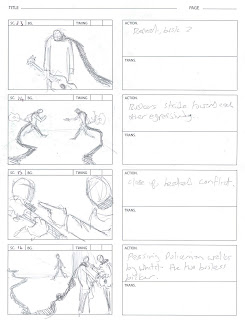
Symmetry plays an important role in this storyboard, as both buskers in their rivalry mirror each other in almost everyway. This is enforced by the scene where both stride across the underpass toward each other agressively. The following scene shows their clash, and again is a close-up, making the drama intimate. The final scene introduces a third party, seen strolling in the background. My composition was crucial here as I needed to shift the focus away from the argument (which at the moment is an eye-catching scenario) and I employed an age-old visual plot device of using the environment or objects, in this case the scarf, as a physical element that draws the eye towards a new focul point, not to mention pushing the bickering pair to the right so as to give wide space to the left for the eye to naturally sweep over at first glance. Very effective.
Here body language becomes key in the absence of dialogue. The third man turns out to be a policeman, made clear by his iconic bobby helmet, and quite literally splits the pair apart, wedging himself inbetween, enforced by his positioning in the center of the frame. With clear character posing, the outstretched hand of the policemen, the slouched demeanour of the exiting buskers and last shot of the pair walking away from each other all do their part to cleary and effectively tell this part of the story.
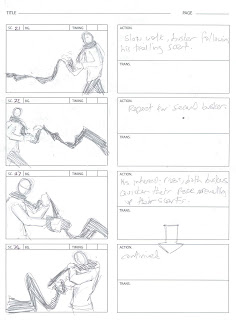 Now dejected, the pair follow their scarf. Here body language works in my favour once again, with each step their frustration becomes more apparent as they grapple with the scarf.
Now dejected, the pair follow their scarf. Here body language works in my favour once again, with each step their frustration becomes more apparent as they grapple with the scarf.
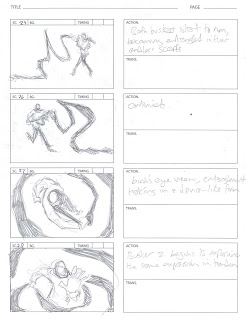
Its here that the story turns into its dance-like form, with the scarf literally taking a life of its own. Overhead shots are useful here as the framing allows the scarf to ribbon around the shot, creating a swirling motion.
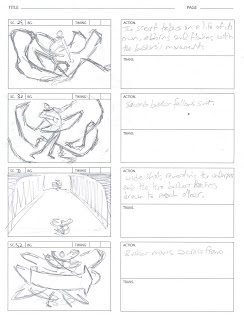
There are often alot of films that blur the action with close-up after close-up, which makes the entire sequence very unreadable- a pet hate of mine, despite how visceral the experience can still end up being, so with the dancing I actually made the composition relatively mundane, and made it so the action in the frame is readable, coherent and speaks for itself. The camera work doesn't need to do much else here.
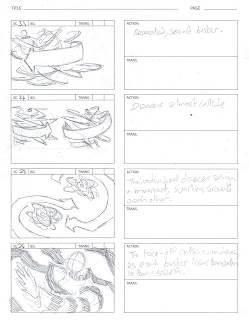
Once again I apply the overhead shots where needed, the pattern and movement of the swirling myriad of scarf can be quite beautiful, and really enforces the dance aspect to this sequence.
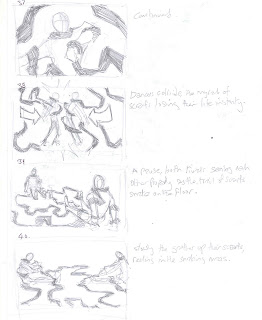
In the above sheet (I ran out of storyboard paper so continued on plain) the dance reaches its peak and subsides as they collide. There are two things that were important in this sequence. Firstly the 'aftermath' of their collision needs to force both parties to face each other during the silence, again continuing the miroring symmetry, and secondly to show the scarf now lifeless and bereft of movement as it snakes along the ground which symbolises the end of the dance.
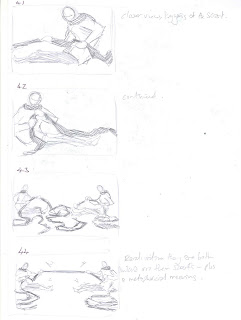
The moment the pair realise their scarfs are not individual but are infact one and the same, that physical link is the defining moment of the entire story. And, usually, such key moments are given a wide birth in their framing for the image to engrave itself in people's minds.
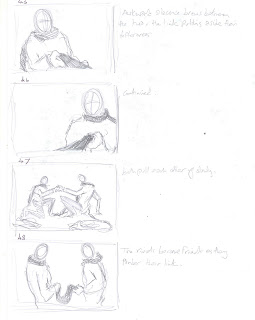
Simple cuts from close ups to wide shots add to the drama as the pair draw closer and closer until in the last frame they are stood opposite each other, both looking down at the one physical link between the two before they burst into dance, this time in union. Again for the action to be readable, the framing is relatively mundane here as the energy within the four walls is enough to keep you occupied.
The above link goes on to talk about the three act structure, which I mentioned earlier, that essentially splits a story into a beggining middle and end. There is a useful list of fundemental elements that a story requires, and in truth every story should be able to tick each of them off.
http://www.dvoted.net/Knowledge/Articles/Film-pre-production/Some-synopsis-examples/
http://www.dvoted.net/Knowledge/Articles/Film-pre-production/Some-synopsis-examples/
Below is an example of one of the synopsis entries in the above link:
''It’s Chicago in the 1920s. The Prohibititon is in effect, which makes the illegal market for hard liquor a profitable business to be in. It’s quickly taken over and controlled by the mob. On top of everything is the cold-hearted businessman and mob-leader, Al Capone. He is untouchable, but others are soon to be too.
Federal agent Elliot Ness is a newcomer at the Chicago Police Department, with the purpose of taking down Al Capone. He quickly realizes the extent of corruption among the crooked cops in the department and assembles a new team of mob-fighters, including the veteran patrolman, Jimmy Malone, who does not have a dishonest bone in his body. He introduces Ness to the Chicago underground and becomes his mentor and friend.
Al Capone pays no attention to the new enforcement, but when Ness and his team suddenly raid one of Capone's liquor warehouses and are named ”The Untouchables”, he gets pissed off. Now the real war begins. Ness has to bring his family to safety in another town. His newly arrived federal accountant is killed by Capone's prime hitman and so is his main witness, a captured gangster.
The effort seems meaningless at this point, but Malone finds the key to the puzzle, Capone's bookkeeper. Unfortunately Malone is killed before he can bring the bookkeeper in. This triggers Ness. He and the last member of his crew, George Stone, get hold of the bookkeeper and secure his witness statement in court, to bring Capone to face a 10 year sentence. Peace in Chicago is restored... for a while.''
The opening paragraph sets the tone, the era, and the backdrop. Its short, simple and already alludes to what is to follow. Chicago in the 1920's already speaks volumes, and the scenario is made clear by the backdrop, and more importantly, how a key character fits into all of this, described as a 'cold-hearted businessman'.
The next part introduces the protagonist, and how his mission sets up the plots series of progressive complications and inevitable conflicts- without a conflict there is no story. Also the sub-plot friendship of Ness and the veteran honest cop is mentioned in brief, setting up the dynamic that later plays out.
The following part reveals the bleakest moment in the story, where everything seems hopeless, and the conflict causes the protagonist and the antagonist to come to severe blows. The crucial part is where the raid makes Al capone 'get pissed off'- it highlights the emotional change in him, and how his retribution causes the protagonist to make a personal change to his life- moving his family to safety.
And then we move to the conclusion, the bleakest moment subsides when the answer reveals itself an the protagonist acts upon it in a last desperate attempt to beat his opponent, sentences such as 'This triggers Ness' are noteworthy, as it pinpoints the motivated drive of our main character which become key to his victory.
Below are some more of the notes I wrote, re-evaluating my busker's story. This time I wanted to try and nail some of the main beats, some of which I revised once the heart of the story became clear after speaking with my tutor and lookin for related existing stories.


Here is the revised (brief only) synopsis of the busker story, as was asked for:
''Two lonely scarf-clad buskers find themselves occupying the same space in a dishevelled underpass. At first they are rivals, and soon lose their ability to play their beloved music by breaking their instruments in a furious face-off. As they spiral into enemies, they both depart on their own, following their path laid before them by the endless ragged scarf trailing off. As they wander alone, they soon become entangled in their frustrations and desire to play music once more, only to find in their dance-like movement they have more in common than they first realised...''
Below are some useful links I found to do with storyboarding, and a little sample I picked out that describes good character introductions.
I really like how the Alfred Hitchcock break-down of his film 'Lifeboat' really demonstates the power of good character intros. Characters are the backbone to any story, and are the driving force of any story. So it is essential that when they first appear, everything about them should be made clear, even if it is revealed at a deliberately slow pace- i.e morally ambiguous characters, for example. Some of my all time favourite character introductions come from director sergio leone, famous for his wild west films.
Below are some videos I've pulled up that demonstrate the language of film at its best, with great composition of shots that introduce characters, setting and story. The first one is a famous animation made by Michael Dudock de wit called the 'Monk and the Fish'. After I explained my potential story idea to my tutor, he pointed me in the direction of this short animation, explaining the similarities of rivals finding they are more alike at the very end. Its a wonderfuly touching piece of storytelling, and clearly demonstrates the crux of my story I am trying to tell.
Reference Videos.
As I mentioned earlier, sergio leone is a huge influence on me and will effect how I will storyboard my story, focusing on emulating the classic mid-shots and close-ups that defined his woks. Below is a prime example of his wonderful casting, compostion and ability to weave tension right up to the moment of conflict.
Another classic film is Deliverance, again this particular scene was suggested to me after I tried to explain the scenario of a duel over music. The dueling banjo sequence from this film sums up the conflict perfectly.
When the scarf comes into play during the sequence of conflict/dance, I envisage it to appear similar to ribbon dancing, and this admittedly random video I found is a great visual explanation of what it is I want.
Beat Board.
With all my influences set, I went about mapping out the story into a few of the main beats. These are crude drawings, and composition and framing is NOT essential here. This is merely a means to capture the idea and soul of the story briefly, a visual synopsis to compliment the written one.

It seems pretty straightforward, and in truth the story is rather simplistic, however that is the beauty of it. A simple story can be enriched by interesting framing, and compelling storytelling interwoven into the plot. Above and below I have tried to capture the main beats, where the story shifts in another direction at key points. The duel playing, the breaking, the argument, the parting of ways, the entanglment, the realisation of the link, the dance-like union.
 There are certain other elements for the storyboard that now need to be applied. I have to consider not only how the main beats punctuate this story, but also how my frame composition compliments the soul of the story, and adds to the momentum of the plot.
There are certain other elements for the storyboard that now need to be applied. I have to consider not only how the main beats punctuate this story, but also how my frame composition compliments the soul of the story, and adds to the momentum of the plot.Storyboarding.

The first page has the opening establishing shot, the underpass setting the grimy tone which immediately reflects the dejected and solemn mood of the buskers. One of my favourite shots is when the camera pans to the side, so the framing of the one character at the foreground slowly reveals the second character in the background, adding to the drama.

With the second sheet I directly borrowed some of leone's classic close ups, using the perspective angle and repeated cuts backwards and forwards, zooming in bit by bit as the face off reaches its peak. Also the dynamic of flitting between extreme close-ups and wide-shots is also very effective. It simultaneously keeps the audience aware of the space and environment, whilst immediately thrusting you intimately into the action.

Symmetry plays an important role in this storyboard, as both buskers in their rivalry mirror each other in almost everyway. This is enforced by the scene where both stride across the underpass toward each other agressively. The following scene shows their clash, and again is a close-up, making the drama intimate. The final scene introduces a third party, seen strolling in the background. My composition was crucial here as I needed to shift the focus away from the argument (which at the moment is an eye-catching scenario) and I employed an age-old visual plot device of using the environment or objects, in this case the scarf, as a physical element that draws the eye towards a new focul point, not to mention pushing the bickering pair to the right so as to give wide space to the left for the eye to naturally sweep over at first glance. Very effective.
Here body language becomes key in the absence of dialogue. The third man turns out to be a policeman, made clear by his iconic bobby helmet, and quite literally splits the pair apart, wedging himself inbetween, enforced by his positioning in the center of the frame. With clear character posing, the outstretched hand of the policemen, the slouched demeanour of the exiting buskers and last shot of the pair walking away from each other all do their part to cleary and effectively tell this part of the story.
 Now dejected, the pair follow their scarf. Here body language works in my favour once again, with each step their frustration becomes more apparent as they grapple with the scarf.
Now dejected, the pair follow their scarf. Here body language works in my favour once again, with each step their frustration becomes more apparent as they grapple with the scarf.
Its here that the story turns into its dance-like form, with the scarf literally taking a life of its own. Overhead shots are useful here as the framing allows the scarf to ribbon around the shot, creating a swirling motion.

There are often alot of films that blur the action with close-up after close-up, which makes the entire sequence very unreadable- a pet hate of mine, despite how visceral the experience can still end up being, so with the dancing I actually made the composition relatively mundane, and made it so the action in the frame is readable, coherent and speaks for itself. The camera work doesn't need to do much else here.

Once again I apply the overhead shots where needed, the pattern and movement of the swirling myriad of scarf can be quite beautiful, and really enforces the dance aspect to this sequence.

In the above sheet (I ran out of storyboard paper so continued on plain) the dance reaches its peak and subsides as they collide. There are two things that were important in this sequence. Firstly the 'aftermath' of their collision needs to force both parties to face each other during the silence, again continuing the miroring symmetry, and secondly to show the scarf now lifeless and bereft of movement as it snakes along the ground which symbolises the end of the dance.

The moment the pair realise their scarfs are not individual but are infact one and the same, that physical link is the defining moment of the entire story. And, usually, such key moments are given a wide birth in their framing for the image to engrave itself in people's minds.

Simple cuts from close ups to wide shots add to the drama as the pair draw closer and closer until in the last frame they are stood opposite each other, both looking down at the one physical link between the two before they burst into dance, this time in union. Again for the action to be readable, the framing is relatively mundane here as the energy within the four walls is enough to keep you occupied.
Rejected sequence.
In making the storyboard there were alot of scenes that I pondered over, and ultimatly cut out due to them adding very little to the main drive of the story.
These were ome rejected sequences where the pair actually used their scarfs against each other during the face off/dance in tug-of-war fashion. Ultimately I streamlined the story and cut these from it because I felt the energy of the story only lasted as long the conflict did, as soon as they become friends then the ending has been achieved-anything else after is fluff and merely stalling the inevitable ending.
Feedback;
Feedback;
After showing the storyboard to a few of my family members, who were not aware of the elements that go into narrative works but rather judge on face value, the feedback was very positive. To them the action was very readable, in particular the body language of the characters, however some pointed out the background could have been established more, and that the policeman felt a little contrived- all fair points. There was also some minor confusion as to which character was which when switching between scenes, something I tried to address by having each character positioned opposite to each other as the sequence flowed. Character expressions was also asked for, however I am a firm believer that facial expressions are the easy route to go down, and in truth its body language that communicates the most- which Is why I deliberately left the faces as blank and focused on teling the story through line of action poses, though of course if this was to be made into a film or animation, then the facial expressions would compliment the body movement. I think the fact most of my family could still tell and feel how the characters were feeling without the aid of facial expressions shows that my poses seem to have done the job effectively.
Evaluation.
Storytelling requires a few fundamental principles and guidelines to follow, examples include the three act structure or/and the main beats as displayed above. However, GOOD storytelling requires you to not only understand these principles, but to alter them, twist them and add imagination using your writing instincts. In essence, to bend the rules you first have to know them. I'm certainly in no position to be bending rules as of yet, but I think my understanding of the basic foundation blocks is sufficient enough for me to begin that process of being comfortable in narrative structuring, and knowing how and when to bend the rules in future to create something compelling. Its amazing to see how often these principles are so often overlooked in modern day storytelling, in any format, and I think the future of comic books, storyboarding, animation and filmmakingin general lies in looking to the past at the old pioneers, such as Hitchcock, Leone, Disney, Kirby etc.
My favourite aspects of this micro project was picking apart existing synopsis, and showing my storyboard work to other people and seeing how they did or didn't read the action. With the synopsis break down it was very important to understand how it was written and to lay it bare before your eyes, in a way akin to taking a puzzle and breaking it up only to discover how to put it back together again. With the storyboard feedback the constructive criticism was enlightening, and refreshing. From their perspective you really gain an understanding of how much you have or havn't learnt the principles and whether you can utilise them effectively. I would certainly like to look into cinematography and script-writing in future which will both help me in my storyboarding specialisation, and pre-production in general. I am still very much in the dark about technical names for various camera angles and shots, and although I seem them all in my mind, its still difficult for me to communicate what it is I want.
In future I hope to become more confident in my storytelling and start to map out various ways of playing around with the rules, and in other places sticking to them where necessary, in order to create a compelling and original piece of narrative. On a side note, this storyboard and beat board process highlights the need for you to understand the crux of your story instantly, because if you have any doubts as to the main 'moral' of the tale, then it shows in your work as it becomes too muddled and incoherent. Also having a firm knowledge of body language, via line of action and extensive life-drawing is also essential here, at least for me.
Overall this is the first step with getting to grips with the basics, and adds a whole new layer of appreciation to the great storytellers, plus this project can act as a wonderful source of reference for myself in the coming days to remind and refresh myself of the principes if and when my mind goes off track.


